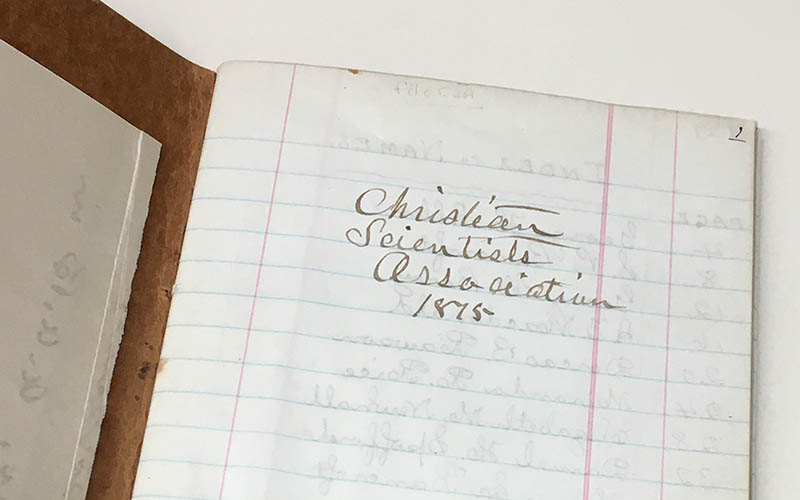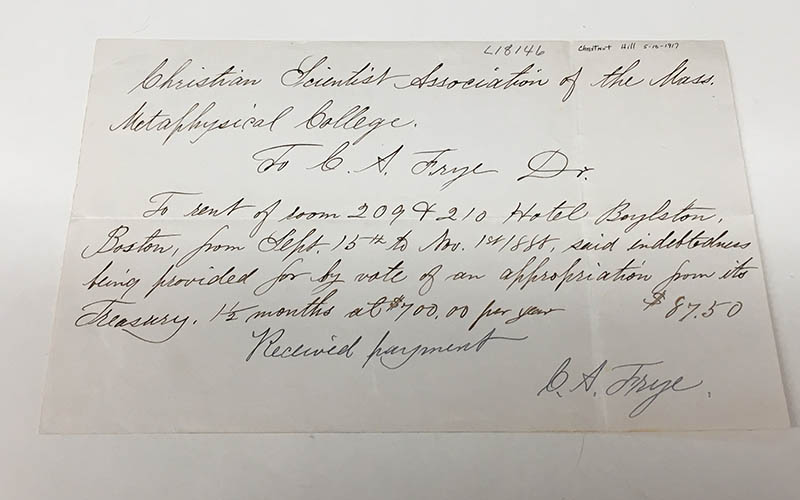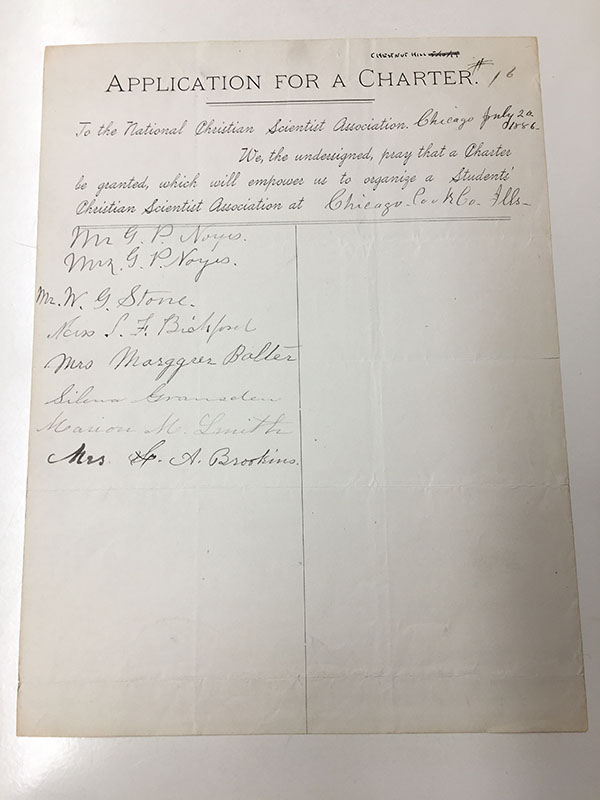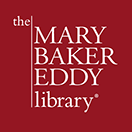From the Collections: A small book notes a big story

Photo of Christian Scientist Association notebook, LSC025 02.15.02.
In 1875, nine students of Mary Baker Eddy formed an unofficial organization. They were some of the first people to take her class in practicing Christian Science. They recorded their names in a small notebook, now housed in our collections, where they also kept track of paid dues.
On July 4, 1876—a date marking the centennial celebration of the United States—Eddy formalized this organization as the Christian Scientist Association (CSA).1 By the time of its dissolution some 14 years later, the CSA had established a lasting influence in the organization and administration of the Christian Science movement, helping to create the first church body, the first Christian Science Reading Room in Boston, and the precursor to The Christian Science Publishing Society.
Eddy had begun regularly teaching students in 1870, two years before starting work on the textbook of Christian Science, which she called Science and Health.2 In this period, the growth of Christian Science depended largely on individual connections; it took place without an administrative foundation or formal church organization. While foremost an organization of Eddy’s students, the CSA undertook other responsibilities. Most significantly, at a meeting held on April 12, 1879, at Eddy’s house in Lynn, Massachusetts, CSA members voted to organize the first Christian Science church.3 That August it was granted a charter as Church of Christ (Scientist) by the Commonwealth of Massachusetts.4
Throughout the 1880s the CSA continued to support the growth of Christian Science, in large part by helping to establish its foundation in publishing. Members also responded to increasing public awareness of Eddy and the new religion she had introduced.
On January 31, 1883, the CSA established the precursor to The Christian Science Publishing Society (CSPS), called the Christian Scientists’ Publishing Company.5 While Eddy retained oversight, the CSA’s role in establishing bodies like this one gives us a good example of how a variety of people helped contribute to the growth of Christian Science.
Another responsibility that fell under the purview of the CSA was the operation of a Christian Science Reading Room. It was housed in rooms 209 and 210 of the Hotel Boylston, then located on the corner of Boylston and Tremont Streets in Boston’s Theater District.6 Like the Christian Science Reading Rooms of today, this was a public-facing venture that sold Eddy’s writings and other Christian Science publications, answered the questions of the surrounding community, and provided a space for reading.7

For the first two years of the Christian Science Reading Room’s
existence in the Hotel Boylston, the receipts for rent looked like
this, the first receipt for rent paid up to November 1888.
The CSA or someone working on its behalf—usually its treasurer (then Mary W. Munroe)—would pay Calvin A. Frye for the rental of the rooms. This was most likely reimbursement for work he had undertaken as Eddy’s secretary, to procure the space. Later on the CSA rented space directly from the Hotel Boylston. Additional records of the CSA detail the materials that the organization purchased from the CSPS and record their Reading Room sales. These records show how the CSA facilitated the spread of knowledge and healing. They help us understand the early ways in which Christian Science connected with the general public.
As the Christian Science movement grew, students of Eddy who completed her Normal class at the Massachusetts Metaphysical College became teachers of Christian Science. The number of Christian Scientists who had not taken a class with Eddy herself, but who were still interested in organizing, grew. In response, the National Christian Scientist Association (NCSA) was organized in January 1886. It granted membership to all students of Christian Science—not just Eddy’s students.8 Increasingly her own students taught classes beyond Massachusetts, establishing a new model for instruction that pushed far beyond New England.
One of the NCSA’s major responsibilities was to grant charters to students’ associations. These groups functioned as branch organizations of Christian Scientists, organized around a particular teacher.9 Smaller affiliated associations, they helped keep all the students of a teacher unified, facilitating their continued learning and connection following the initial class instruction. These branch associations submitted annual reports to the central NCSA about their membership and activities. They also sent representatives to annual meetings,10 that took place in different locations—Boston in 1886 and 1887; Chicago in 1888; Cleveland in 1889; and New York City in 1890. This made it easier for students who lived further west to keep in contact with fellow Christian Scientists.11

Application for charter, for branch association of students of Caroline D. Noyes of Chicago. Association No. 16.
One such Students Christian Scientist Association was organized around the pupils of Caroline D. Noyes. A native of Maine, she went to Chicago in 1883 to aid the growth of Christian Science in the Midwest. She became a certified teacher of Christian Science in 1885, while running the Illinois Christian Scientist Institute and helping to organize the first Chicago branch of the Church of Christ (Scientist).12 Noyes’ application for a branch association was the sixteenth overall, and one of the first in the Midwest.13
As time went on, Christian Science increasingly became an international religion with a growing number of churches. In response Eddy reorganized the church structure, with the establishment of The First Church of Christ, Scientist, and the construction of a publishing house. The CSA became an informal organization in 188914 and ceased managing the Boston Reading Room in 1894.15 In 1893 the NCSA disbanded, after having met for the first time in three years, at the World’s Parliament of Religions at the Chicago World’s Fair.16 During its adjournment, it continued to approve charters for branch associations. But eventually these organizations became more independent, until they evolved into Christian Science students’ associations as we know them today.
The CSA and NCSA showed marked differences from the current organizational structure of the Christian Science movement. Yet their work was significant, evolutionary, and vital. They paved the way for many of the activities that serve today’s Church of Christ, Scientist.
Explore more about the early years of Christian Science at The Mary Baker Eddy Library, through finding aids for the Early Organizational Records of the Mary Baker Eddy Collection, as well as Library Special Collections, such as the Christian Scientist Association Records (LSC025) and the National Christian Scientist Association Records (LSC026).
- Christian Scientist Association, record book, Vol. 1, n.d., EOR10, 1.
- “A Chronology of Events Surrounding the Life of Mary Baker Eddy,” The Mary Baker Eddy Library, 10 December 2018, https://www.marybakereddylibrary.org/wp-content/uploads/2018/12/Mary_Baker_Eddy_Detailed_Annotated_Chronology_2018-12-10.pdf, 11–12, 13.
- Christian Scientist Association, meeting minutes, Vol. 1, 12 April 1879, EOR10, 69.
- Church of Christ, Scientist, record book, 23 August 1879, EOR13, 89.
- Christian Scientist Association, meeting minutes, Vol. 1, 17 January 1883, EOR10, 189–190.
- “A New Home,” The Christian Science Journal, September 1888, 317.
- For more information on the history of Christian Science Reading Rooms, read the Library’s research article Christian Science Reading Rooms 1887–1910.
- “A National Association,” Journal, February 1886, 209-210.
- National Christian Scientist Association, meeting minutes, n.d., EOR31, v.
- Ibid., x–xi.
- “A Chronology of Events Surrounding the Life of Mary Baker Eddy,” 10 December 2018, https://www.marybakereddylibrary.org/wp-content/uploads/2018/12/Mary_Baker_Eddy_Detailed_Annotated_Chronology_2018-12-10.pdf, 31.
- https://www.marybakereddylibrary.org/research/women-of-history-caroline-noyes/.”
- “Students Christian Scientist Association,” n.d., LSC026.
- “Editor’s Note Book,” Journal, December 1889, 459.
- Christian Scientist Association, meeting minutes, 30 July 1894, LSC025.
- “Christian Science at the World’s Religious Congress,” Journal, November 1893, 337–346.

